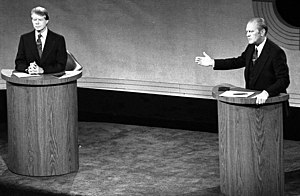
Back مقرأ Arabic Letrin Breton Pulpit Czech Darllenfa Welsh Pult German Αναλόγιο Greek Libropupitro Esperanto Atril Spanish Kantore (euskarria) Basque میز خطابه Persian

A lectern is a standing reading desk with a slanted top, on which documents or books are placed as support for reading aloud, as in a scripture reading, lecture, or sermon. A lectern is usually attached to a stand or affixed to some other form of support. To facilitate eye contact and improve posture when facing an audience, lecterns may have adjustable height and slant. People reading from a lectern, called lectors, generally do so while standing.
The word has its origins in the medieval Latin term lectrum, related to legere which means 'to read'.[1] In pre-modern usage, the word lectern was used to refer specifically to the "reading desk or stand ... from which the Scripture lessons (lectiones) ... are chanted or read."[2] One 1905 dictionary states that "the term is properly applied only to the class mentioned [church book stands] as independent of the pulpit."[3] By the 1920s, however, the term was being used in a broader sense; for example, in reference to a memorial service in Carnegie Hall, it was stated that "the lectern from which the speakers talked was enveloped in black."[4] Lecterns are frequently also referred to as podiums, a word which can also refer to an elevated platform upon which a lectern is placed, derived from the Latin root pod-, meaning 'feet'.[1]
- ^ a b Petroski, Henry (2016). "Engineering: Lecterns Are Not Podiums". American Scientist. 104 (6): 342–345. ISSN 0003-0996.
- ^ Lectern, Chambers's Cyclopaedia, Vol. VI W. and R. Chambers, 1864; pp. 71-72.
- ^ D. C. Gilman, H. T. Peck and F. M. Colby (eds), Lectern, The New International Cyclopaedia, Vol. XII, Dodd, Mead and Co., 1905; p. 68.
- ^ Domestic News: New York, The Reform Advocate, Vol LV, No. 7, September 18, 1920; p. 181.